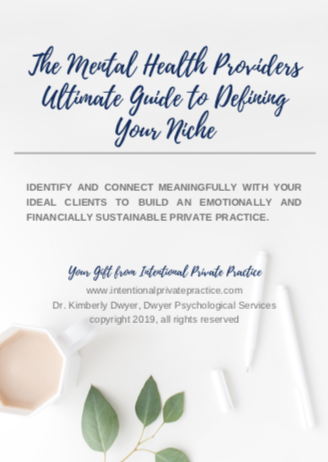Top of the marketing list for therapists with any kind of web-presence is SEO. But… what does that mean exactly, and how do you capitalize on SEO? Do you need to pay someone, or can you DIY your therapist SEO? In this blog article, I’ll hit my top 7 recommendations for therapist SEO.
But first, what is SEO? SEO stands for Search Engine Optimization. It includes all the things that help your website (or your page or blog post, etc) jump higher up in the list when a potential client is using a search engine (like google, bing, yahoo, etc) to look for someone like you. Therapist SEO is impacted by a variety of factors, many of which I’ll focus on in this article. In short, there are a lot of things a therapist can do without much effort to improve SEO. It isn’t hard, but it takes some deliberate and intentional focus on the elements that improve SEO.
(Are you more of a visual person? Check out my video discussing Therapist SEO in the Facebook group.)
1. Keywords/Key phrases for Therapist SEO
Think of keywords or key phrases as your ideal client population’s search terms when they use a tool like Google to find you. Think about the words that your absolutely-perfect-fit client would use to describe what they are looking for in a therapist. Those words will likely be your keywords. Do you work with children with anxiety disorders? Then “children” and “anxiety” are likely good keywords for you. You could write an article about anxiety in children. Even better, you could take this topic and spread it out over a series of articles, for instance, what does anxiety look like in children, anxiety and sleep in children, parenting children with anxiety, supporting anxious children in school, and how anxiety changes from childhood to adolescence. Given that you probably know a lot about your ideal client population’s needs, you could probably generate a list of a dozen topics easily around your area of expertise.
Your keyword could be one word, for instance, in my example, I could have just used “anxiety.” But I would have a lot of competition–there’s a lot of information out there about anxiety. By targeting my therapist SEO using a key phrase like “childhood anxiety”, or even better “[my location] childhood anxiety”, I’m going to target a more specific population. And that population is likely going to be more interested in what I am sharing. Even better, if I use my location and “childhood anxiety”, then someone searching for a therapist in my specific city for childhood anxiety is more likely to find me, and, in turn, I am going to be a better fit for them than, say, someone who is a thousand miles away.
Use your keywords throughout your article or webpage: in the title of the article, throughout the article, in your URL, and especially in your opening paragraph to take full advantage of your therapist SEO. (Don’t worry, we’ll talk about several of these areas in more detail later in this article). In my example of childhood anxiety, I would want those keywords to show up in the title of my article, throughout my article, and especially in my opening paragraph and in my subheadings. I could call my article “Treating Childhood Anxiety in Denver” (my city), and in my opening paragraph I could talk about why I’m passionate about treating childhood anxiety and how excited I am to offer my services to residents of Denver and the surrounding areas. I’d want to hit on these key words multiple times in my opening paragraph especially, but also throughout my article, to increase my SEO. My URL could be mywebpage.com/childhood-anxiety-denver. The “childhood-anxiety-denver” portion of the URL is the “slug” and it is my keyphrase.
Another important consideration is to have unique key phrases on each page or blog you write. Don’t reuse your key phrases! In SEO language, that’s called canibalization. It puts your content in competition with your own content. Instead, come up with variations. For instance, I could write “childhood anxiety denver” and then write “childhood anxiety symptoms” and “childhood anxiety treatment.” While similar, they are going to each hit a separate target audience and they won’t be in competition with each other.
As a therapist, SEO may benefit from keyword research. Before going further, take some time to brainstorm keywords and key phrases for your ideal client population. For each key phrase, devise content that speaks to that key phrase to increase your therapist SEO. Need help zoning in on your ideal client? Check out my free
Ultimate Guide to Defining Your Niche in my Resource Vault! Then, get going on some key word research.
This article from Yoast about key word research is also helpful.
2. Subheadings for Therapist SEO
You also will benefit in optimizing your blogs or webpages when you use subheadings. Subheadings break up your text into chunks, making it easier for your reader to scan and orient themselves to your topic. Ideally, your subheadings should also speak to your keywords or phrases.
To easily create subheadings, think about breaking up your article or content into chunks and then giving each chunk or paragraph its own heading. This is not how I naturally write, so adding headings has been a learning process for me. But if you have solid paragraph structure, then it should not be too hard to add a heading.
In the example I’m using, my key phrase is childhood anxiety. In an article about how does childhood anxiety show up, I might have subheadings like “emotional dysregulation,” “fears”, “avoidance”, “sleep problems”, and “friendships.” To strengthen this, I could make my subheadings “childhood anxiety: fears”, and “childhood anxiety: avoidance.”
Not sure how to do subheadings and want an easy fix? Make a bulleted list as you organize your article. Those bullets become your headings. Or, write a “top 5” article and each item in your top 5 (or whatever number) becomes one of your subheadings.
3. URLs for Therapist SEO
Do you give much thought to the URL for your articles and pages? The URL is a “uniform resource locator” (I had to look that up!) and it is the unique address of your page. It starts with your domain and then a slash and then the page, for instance,
www.intentionalprivatepractice.com/contact will take you to my “contact me” page on my website.
If you don’t specify the URL, then your website builder may automatically be assigning your pages a URL based on your first heading or title (which can be just fine, or can be a poor fit). Some builders will give a number instead of words, and you really don’t want that as it does not help you one bit for therapist SEO. Give your pages and blog articles a unique URL that reflects your keywords and you will improve SEO.
Not sure how to change the URL? You should be able to find this in your builder. The “slug” is the portion after your website that indicates where your page or article “lives”… in my link, above, the slub is “contact.” On this page that you are currently reading, the slug is “therapist-seo”. (Sensing a theme?). You should see an option in your page/blog builder to “edit” the slug. If you have solid page or article titles that reflect your keywords, you can easily translate that into URLs that will be great for therapist SEO.
4. Outbound Links
Including links that leave your website helps to improve your therapist SEO. Where should you link? Well that’s up to you, but some useful ideas would be further information that supports your article, further resources, or anything else connected to your topics. You can also clap back to other pages within your own website… for instance, if you end your blog or page suggesting interested parties contact you to schedule, you can include a link to the page of your website with your contact information.
5. Inbound Links
Your therapist SEO improves if other pages link to your website. How does one do this? Create great content and share it with other folks who might want to link to it. You also create inbound links when you list your website elsewhere, such as in directories. Being quoted in articles that then link back to your website is another option to create inbound links. You can find opportunities to be quoted in articles through Help a Reporter Out. For examples of how I’ve used HARO to be quoted and drive traffic back to my webpage, look at these article resources on my clinical webpage (“in the news” about halfway down the home page). Finally, you can link to your own material–for instance, link a blog article that ends in a call to action to your contact page as I suggested above.
6. Images
Do you give much attention to the images you include in your blog articles? When you add an image to an article, you can change the alt text to match your article (sometimes the default will be blank or the image file name). This gives you another chance to hit a keyword and to help make your webpages more accessible. If you are writing an article about childhood anxiety, you might have an image that fits your article, and change the alt text to childhood anxiety. Image descriptors are also used by blind and visually impaired readers, so make sure you are including useful information to benefit all of your readers while also improving your therapist SEO.
7. Article Length for Therapist SEO
What’s the perfect article length? Guess what, it’s probably longer than you think. Minimally, blog articles should have at least 300 words. But SEO algorithms favor longer articles. Ultimately, the length of time that your reader stays on the page (ie, reads or otherwise interacts with your article) improves your therapist SEO. So a great article that hooks your reader quickly is going to be better than a long article that loses people after a few sentences.
In terms of just optimizing length, I’ve read anything from 1500-2000 words, with
this article from Hook Agency highlighting the need for 1760-2400 words. There are also strategies to pull your reader in and let them think they are reading something shorter–add images, videos, bulleted lists, headings, etc.
In terms of expanding your writing to hit a higher word count and improve therapist SEO, consider not just answering the main question your article addresses, Brainstorm ancillary questions that sprout off from your central topic, and answer those, too. Don’t be afraid to re-purpose content and talk about issues in a slightly different way.
Getting Meta about Therapist SEO
Interested in seeing these strategies in action? Guess what, you just did! I was intentional to use these 7 therapist SEO hacks throughout the article you are currently reading. My key phrase “therapist SEO” occurs in my title, throughout my article, and in my URL slug. I generated the content for this article based on a question my ideal coaching client frequently asks: What is SEO anyway and how do I improve it? I used subheadings and included outbound links, including to my own clinical website (which will generate inbound links for that website). I created an inbound link by finding a past blog I wrote on marketing and adding a link to this article. My article length is 1923 words and I changed my featured image alt text to my key phrase.
I love working with therapists to increase their practice through marketing, mindset, money, and management. Hop over to my facebook group for the inside scoop and reach out for an initial consultation!





